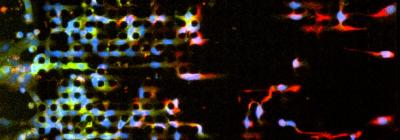Massachussetts General-developed device monitors key step in development of tumor metastases

As cells undergoing the epithelial-mesenchymal transition move from left to right through the EMT chip, those expressing mesenchymal markers (red) break away and move independently from other cells, while cells expressing epithelial markers (green) continue to move as a collective front. Credit: BioMEMS Resource Center, Massachusetts General Hospital
In their report published in Nature Materials, the investigators describe an stands for epithelial-mesenchymal transition, a fundamental change in cellular characteristics that has been associated with the ability of tumor cells to migrate and invade other sites in the body. Therapies that target this process may be able to slow or halt tumor metastasis.
“This device gives us a platform to be used in testing and comparing compounds to block or delay the epithelial-mesenchymal transition, potentially slowing the progression of cancer,” says Daniel Irimia, MD, PhD, associate director of the BioMEMS Resource Center in the MGH Department of Surgery.
Normally a stage in embryonic development, EMT is important during normal wound healing and also appears to take place when epithelial cells lining bodily surfaces and cavities become malignant. Instead of adhering to each other tightly in layers, cells that have undergone EMT gain the ability to separate out, move to other parts of the body and implant themselves into the new sites. Cells that have transitioned into a mesenchymal state appear to be more resistant to cancer therapies or other measures designed to induce cell death.
The device developed at the MGH allows investigator to follow the movement of cells passing through a comb-like array of micropillars, which temporarily separates cells that are adhering to each other. To establish baseline characteristics of noncancerous cells, the investigators first studied the passage of normal epithelial cells through the array. They observed that those cells moved at the same speed as neighboring cells, reconnecting when they come into contact with each other into multicellular sheets that repeatedly break apart and reseal. Tumor cells, however, passed quickly and more directly through the device and did not interact with nearby cells.
When cells in which the process of EMT had been initiated by genetic manipulation were observed passing through the device, at first they migrated collectively. But soon after encountering the first micropillars, many cells broke away from the collective front and migrated individually for the rest of their trajectory.
Some cells appeared to undergo the opposite transition, reverting from individual migration back to collective migration. Subsequent analysis revealed that the slower moving cells that continued migrating together expressed epithelial markers, while the faster moving, independently migrating cells expressed mesenchymal markers. The individually cells migrating also appeared to be more resistant to treatment with chemotherapy drugs.
A particular advantage of the EMT chip is the ability to observe how the behavior of a population of cells changes over time. “Instead of providing a snapshot of cells or tissues at a specific moment, as traditional histology studies do, the new chip can capture the changing dynamics of individual or collective cellular migration,” explains Irimia, an assistant professor of Surgery at Harvard Medical School.
“In the controlled environment of the EMT chip, these processes resemble such phase transitions as the change from solid to liquid that occurs with melting. Analogies with well studied physical processes are very useful for summarizing the complex EMT process into a few parameters. These parameters are very helpful when making comparisons between different cell types and studying the contribution of various biological processes to EMT. They are also useful when comparing different chemicals to discover new compounds to block or delay EMT”
Ian Wong, PhD, formerly of the BioMEMS Resource Center and now at the Brown University School of Engineering, is lead author of the Nature Materials paper. Additional co-authors are Elisabeth Wong, Sinem Park, PhD, and Mehmet Toner, PhD, BioMEMS Resource Center; and Sarah Javaid, PhD, and Daniel Haber, MD, MGH Cancer Center. The study was supported by grants from the Merck Fellowship of the Damon Runyon Cancer Research Foundation, Howard Hughes Medical Institute, and National Institutes of Health grants CA129933, EB002503, CA135601 and GM092804.
Massachusetts General Hospital, founded in 1811, is the original and largest teaching hospital of Harvard Medical School. The MGH conducts the largest hospital-based research program in the United States, with an annual research budget of more than $785 million and major research centers in HIV/AIDS, cardiovascular research, cancer, computational and integrative biology, cutaneous biology, human genetics, medical imaging, neurodegenerative disorders, regenerative medicine, reproductive biology, systems biology, transplantation biology and photomedicine.
Media Contact
All latest news from the category: Life Sciences and Chemistry
Articles and reports from the Life Sciences and chemistry area deal with applied and basic research into modern biology, chemistry and human medicine.
Valuable information can be found on a range of life sciences fields including bacteriology, biochemistry, bionics, bioinformatics, biophysics, biotechnology, genetics, geobotany, human biology, marine biology, microbiology, molecular biology, cellular biology, zoology, bioinorganic chemistry, microchemistry and environmental chemistry.
Newest articles

Security vulnerability in browser interface
… allows computer access via graphics card. Researchers at Graz University of Technology were successful with three different side-channel attacks on graphics cards via the WebGPU browser interface. The attacks…

A closer look at mechanochemistry
Ferdi Schüth and his team at the Max Planck Institut für Kohlenforschung in Mülheim/Germany have been studying the phenomena of mechanochemistry for several years. But what actually happens at the…

Severe Vulnerabilities Discovered in Software to Protect Internet Routing
A research team from the National Research Center for Applied Cybersecurity ATHENE led by Prof. Dr. Haya Schulmann has uncovered 18 vulnerabilities in crucial software components of Resource Public Key…





















